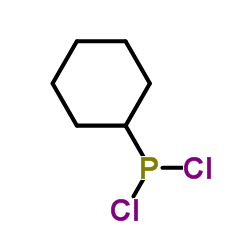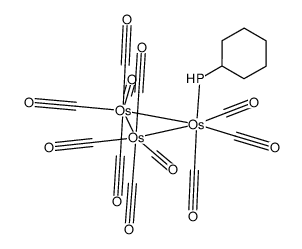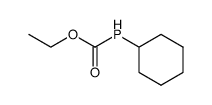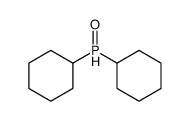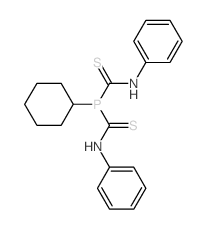822-68-4
| Name | cyclohexylphosphane |
|---|---|
| Synonyms |
Phosphine,cyclohexyl
mono-cyclohexylphosphine MFCD00014297 (cyclohexyl)PH2 cyclohexyl-phosphine |
| Density | 0.875 g/cm3 |
|---|---|
| Boiling Point | 145ºC |
| Molecular Formula | C6H13P |
| Molecular Weight | 116.14100 |
| Flash Point | -21ºC |
| Exact Mass | 116.07500 |
| PSA | 13.59000 |
| LogP | 2.19420 |
|
Section 1: Product Identification Chemical Name:Cyclohexylphosphine, min. 97%(Sure Seal TM bottle) CAS Registry Number:822-68-4 Formula:C6H11PH2 EINECS Number:none Chemical Family:organophosphorus ligand Synonym:none
Section 2: Composition and Information on Ingredients IngredientCAS NumberPercentACGIH (TWA)OSHA (PEL) Title Compound822-68-4100%no datano data Section 3: Hazards Identification Harmful by inhalation, in contact with skin and if swallowed. Material has a pungent odor. Inhalation of vapors Emergency Overview: may lead to headache and dizziness. Primary Routes of Exposure:Ingestion, skin, inhalation Eye Contact:May cause mild to severe irritation of the eyes. Skin Contact:Harmful in contact with skin. May cause mild irritation of the skin, or thermal burns if ignited. Harmful by inhalation. Inhalation may lead to headaches and dizziness. May be irritating to nose and mucous Inhalation: membranes. Ingestion:Harmful if swallowed. May cause vomiting and diarrhea. Acute Health Affects:Harmful by inhalation, in contact with skin and if swallowed. Chronic Health Affects:No information available on long-term chronic effects. NTP:No IARC:No OSHA:No SECTION 4: First Aid Measures Immediately flush the eyes with copious amounts of water for at least 10-15 minutes. A victim may need Eye Exposure: assistance in keeping their eye lids open. Get immediate medical attention. Wash the affected area with water. Remove contaminated clothes if necessary. Seek medical assistance if Skin Exposure: irritation persists. Remove the victim to fresh air. Closely monitor the victim for signs of respiratory problems, such as difficulty Inhalation: in breathing, coughing, wheezing, or pain. In such cases seek immediate medical assistance. Seek medical attention immediately. Keep the victim calm. Give the victim water (only if conscious). Induce Ingestion: vomiting only if directed by medical personnel. SECTION 5: Fire Fighting Measures Flash Point:no data Autoignition Temperature:pyrophoric Explosion Limits:Pyrophoric Extinguishing Medium:carbon dioxide, dry powder or foam The pyrophoric liquid may reignite. Fire fighters should be equipped with an approved positive pressure Special Fire Fighting Procedures: self-contained breathing apparatus and full protective clothing. Hazardous Combustion andIf involved in a fire this material may emit toxic organic fumes and vapors of phosphorus pentoxide. Decomposion Products: Unusual Fire or Explosion Hazards: Spontaneously flammable in air, especially in contact with organic matter such as paper or cloth. SECTION 6: Accidental Release Measures 'The material may ignite spontaneously in air. Avoid static discharge. Burning material may release toxic fumes. In case of poor ventilation, leave the area unless fitted with a self-contained breathing apparatus. Spill and Leak Procedures: Small spills can be mixed with ground limestone, sodium bicarbonate, or other suitable absorbents, swept up, and held in a closed metal can. SECTION 7: Handling and Storage Store in a tightly sealed container under an inert atmosphere of nitrogen or argon. Keep away from heat. Handling and Storage:Material should be transferred under an inert atmosphere of nitrogen or argon in a efficient fume hood. Fire may occur in emptied container and transfer lines. SECTION 8: Exposure Controls and Personal Protection Eye Protection:Always wear approved safety glasses when handling a chemical substance in the laboratory. Skin Protection:Wear protective clothing and gloves. Ventilation:Material has a pungent odor. Always handle material in an efficient fume hood. If ventilation is not available a respirator should be worn. The use of respirators requires a Respirator Respirator: Protection Program to be in compliance with 29 CFR 1910.134. Ventilation:Material has a pungent odor. Always handle material in an efficient fume hood. Additional Protection:Wear a full face shield, flame resistant lab apron and suitable gloves. SECTION 9: Physical and Chemical Properties Color and Form:colorless liq. Molecular Weight:116.14 Melting Point:no data Boiling Point:145°C Vapor Pressure:no data Specific Gravity:0.8750 Odor:pungent, offensive odor Solubility in Water:insoluble SECTION 10: Stability and Reactivity Stability:air-sensitive liquid - pyrophoric Hazardous Polymerization:no hazardous polymerization Contact with air. Material may spontaneously ignite, especially in the presence of organic matter such as Conditions to Avoid: paper or cloth. Incompatibility:oxidizing agents, halogens, air (pyrophoric), halocarbons, sulfur. Decomposition Products:carbon dioxide, carbon monoxide, organic vapors, and phosphorus pentoxide. SECTION 11: Toxicological Information RTECS Data:No information available in the RTECS files. Carcinogenic Effects:No data available Mutagenic Effects:No data available Tetratogenic Effects:No data available SECTION 12: Ecological Information Ecological Information:No information available SECTION 13: Disposal Considerations Disposal:Dispose of according to local, state and federal regulations. SECTION 14: Transportation Shipping Name (CFR):Pyrophoric liquids, organic, N.O.S. Hazard Class (CFR):4.2 Additional Hazard Class (CFR):NA Packaging Group (CFR):I UN ID Number (CFR):UN# 2845 Shipping Name (IATA):Forbidden Hazard Class (IATA):NA Additional Hazard Class (IATA):NA Packaging Group (IATA):NA UN ID Number (IATA):UN# 2845 SECTION 15: Regulatory Information TSCA:Not listed in the TSCA inventory. SARA (Title 313):Not reportable under SARA Title 313 Second Ingredient:none SECTION 16 - ADDITIONAL INFORMATION N/A |
| Risk Phrases | 17-20/21/22-34 |
|---|---|
| Safety Phrases | 9-16-26-36/37/39 |
| RIDADR | UN 3185 |
|
~% 
822-68-4 |
| Literature: Ullah, Ehsan; McNulty, James; Larichev, Vladimir; Robertson, Al J. European Journal of Organic Chemistry, 2010 , # 35 p. 6824 - 6830 |
|
~% 
822-68-4 |
| Literature: Stiles et al. Journal of the American Chemical Society, 1952 , vol. 74, p. 3282 |
|
~% 
822-68-4 |
| Literature: Pass; Schindlbauer Monatshefte fuer Chemie, 1959 , vol. 90, p. 148,153 Full Text Show Details Horner et al. Chemische Berichte, 1958 , vol. 91, p. 1583,1588 |
|
~% 
822-68-4 |
| Literature: Natarajan, Karuppannan; Zsolnai, Laszlo; Huttner, Gottfried Journal of Organometallic Chemistry, 1981 , vol. 220, # 3 p. 365 - 382 |
|
~% 
822-68-4 |
| Literature: Thamm, Ruediger; Fluck, Ekkehard Zeitschrift fuer Naturforschung, Teil B: Anorganische Chemie, Organische Chemie, 1981 , vol. 36, # 8 p. 910 - 916 |
| Precursor 5 | |
|---|---|
| DownStream 5 | |
